#pseudotoothed birds
Note
Which palaeontological data gap or debate would you most like resolving?
what the fuck are pelagornithids and where the heck do they go
63 notes
·
View notes
Text

Branching out a bit more into the Cenozoic featuring Pelagornis, possibly the largest flying bird.
Always been a huge fan of it's unique beak.
#my art#paleoart#sciart#pelagornis#pelagornithidae#pseudotooth bird#cenozoic#bird#aves#extinct#seabird#nature
202 notes
·
View notes
Text
Spectember 2023 #04: Some Aukward Birds
An anonymous submitter asked for a "penguin/auk-like relative of Pelagornis":

Odontopinguinus vomitus represents an unusal early branch of the pelagornithids that didn't take up long-distance soaring, instead specializing for a pursuit diving lifestyle convergently similar to that of the contemporaneous early penguins, and the later auks and plotopterids.
About 1.2m tall (~4'), it has a more slender spear-like beak than its relatives, with forward-pointing pseudotooth serrations. Like other pelagornithids these "teeth" are fairly fragile, so it feeds primarily on soft-bodied fish and squid, pursuing them underwater with wing-propelled underwater "flight".
Much like procellariiformes they're also rather stinky birds, producing musky preen oil and projectile vomiting foul-smelling stomach contents at threats and rivals.
———
And another anon wanted to see a "big flightless marine duck":
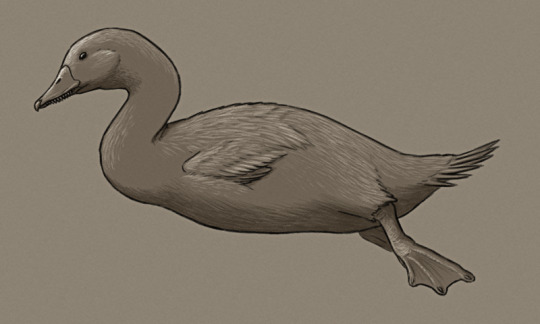
Thalassonetta anambulatus is descended from the already mostly-flightless steamer ducks. At around 2m long (6'6") it's massive for a waterfowl, with vestigial wings and large webbed feet used to propel itself while diving.
With its rather elongated and heavy body and loon-like leg configuration it's no longer able to walk on land – and it's actually almost fully aquatic, only awkwardly hauling out into isolated island beaches to molt and breed.
It feeds mainly on molluscs, crustaceans, and other marine invertebrates, using the large lamellae in its bill to strain them out of soft seafloor sediments.
#spectember#spectember 2023#speculative evolution#pelagornithid#duck#bird#dinosaur#art#science illustration
302 notes
·
View notes
Text
Fossil Novembirb: Day 16 - Among The Giants

During the Oligocene epoch, 33-23 million years ago, the landscape of Mongolia was as endlessly vast and wild as today. Forests were rare in this part of the world, instead there were shrublands, savannahs and deserts there. This landscape was the realm of giants, like the Paraceratherium of Walking With Beasts fame. Birds were also living in this land of giants, and some were already adapting to it.
Heterostrix: A small early owl, roughly the size of modern pygmy owls. But despite its small size, it was a capable predator of large insects, lizards and mammals, even birds as large as itself.
Agnopterus: One of the earliest known true flamingoes. Little is known of this bird, but it likely fed on tiny crustaceans filtered from the water, as do modern flamingoes.
Sonogrus: One of the flightless paleognath birds that was closely related to ostriches. This fleet footed herbivore belonged to the group known as paragruids.
Ergilornis: Another stem-ostrich in the group known as ergilornithids. The inner toe of these birds was reduced in size to allow for more efficient running.
Caspiodontornis: One of the few pelagornithids known from Asia, this pseudotoothed giant flew above the remnants of the ancient Tethys Sea.
#Fossil Novembirb#Novembirb#Dinovember#birblr#palaeoblr#Birds#Dinosaurs#Cenozoic Birds#Heterostrix#Agnopterus#Sonogrus#Ergilornis#Caspiodontornis
62 notes
·
View notes
Text
Palorchestes, a cenozoic weird-faced marsupial
Pelagornis, a cenozoic pseudotoothed birds
Phascolonus, a cenozoic giant wombat
Phoeniconotius, a cenozoic buff flamingo
Platypterygius, a cretaceous icthyosaur
Procoptodon, a cenozoic short-faced kangaroo
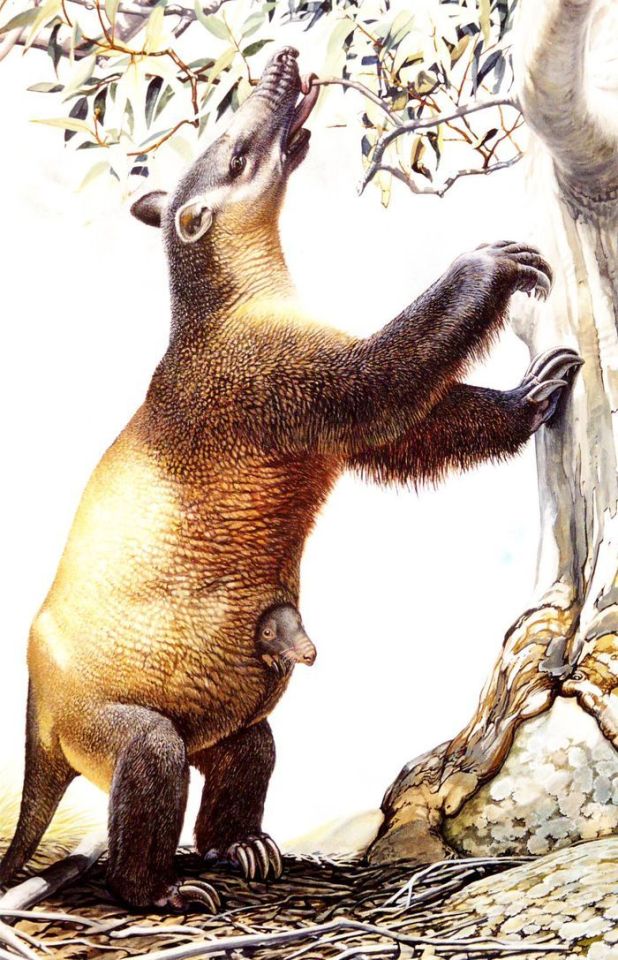

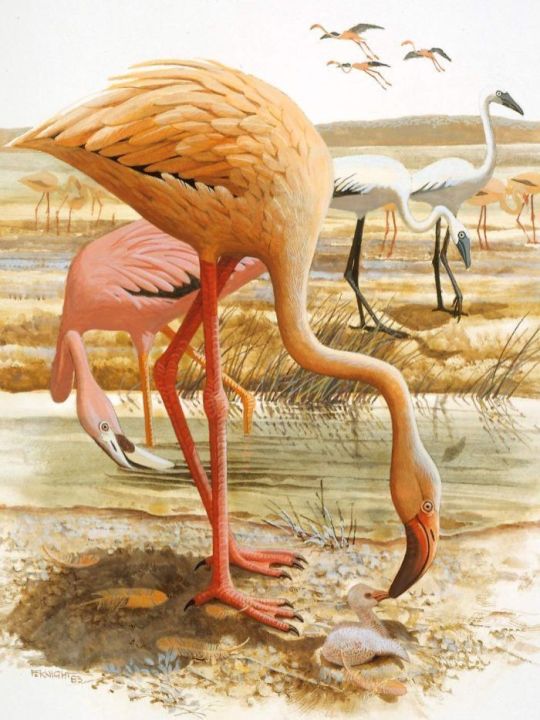



#palaeoblr#australian fossil alphabet thing#megafauna#Palorchestes#Pelagornis#Phascolonus#Phoeniconotius#Platypterygius#Procoptodon
22 notes
·
View notes
Text
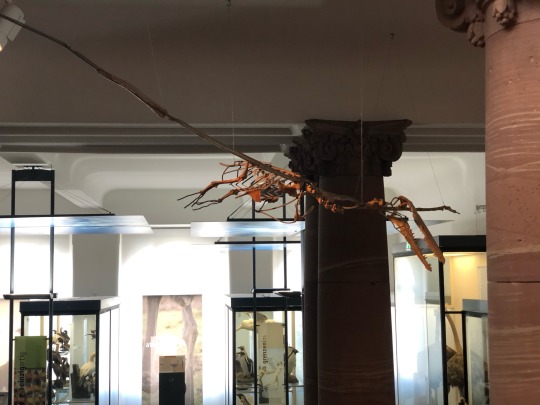
Pelagornis, a pseudotooth bird from the Miocene.
6 notes
·
View notes
Text
The Terror Bird Monstar appears, Pelagalein!

Description:
"An extremely dangerous Monstar that dominates the coastal isles it lives on. Should the crew of a ship see a Pelagalein, they will turn around to avoid the hulls being torn apart by their hardened beaks. A Pelagalein's bite force is strong enough to shred iron and steel."
Pelagalein's name is made of three parts: PELAGORNIS, GALE, and KERATIN. The 'gale' part is in reference to the large, monstrous wings of the Monstar, while both other parts reference the inspiration for the Monstar itself, the pelagornis.

The pelagornis is both a member of and the name for a genus of prehistoric birds that used to occupy many areas of the prehistoric world. Pelagornis is thought to be the ancestral relatives of aquatic birds such as pelicans, storks, and other waterfowl such as ducks and geese. They are known as pseudotooth birds for the keratinous growths that line their beaks, resembling teeth, allowing them to better grip the slippery fish and aquatic life they preyed upon. They also had wingspans close to 20 feet long! Despite the large amount of members in the family, very little complete fossil records have been found due to their lightweight bones being crushed over time and improperly fossilized.
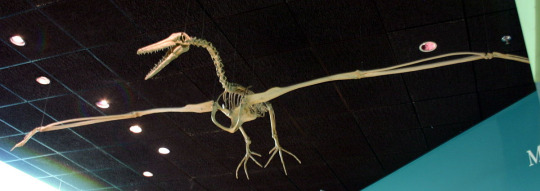
3 notes
·
View notes
Text

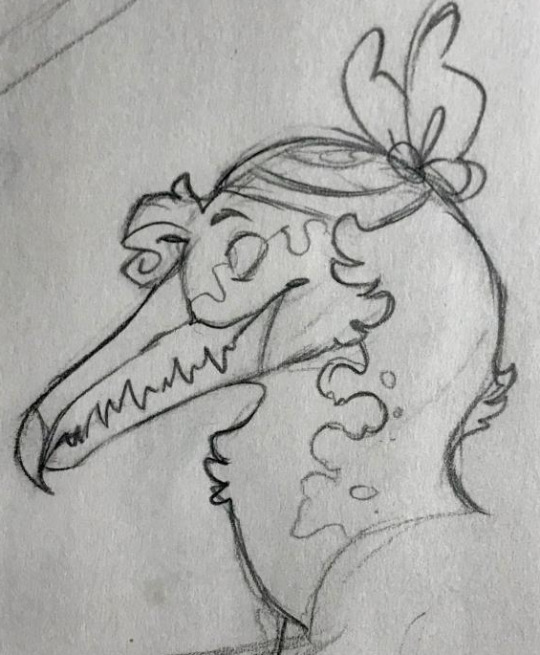
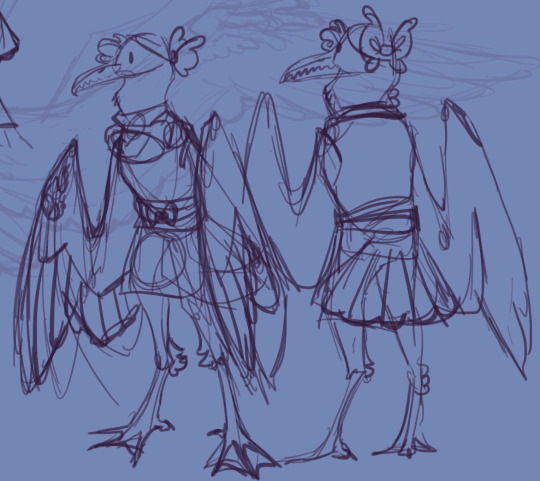
pelagornis palina!!! this one was SO much fun to do, especially with her absolutely wack proportions.
pelagornis, an extinct seabird that holds the record for the largest wingspan of any bird ever known, at 20-24 ft! that's about twice that of the largest extant bird's wingspan, the ~11ft wandering albatross. pelagornis is one of the pseudotooth birds- those serrations on the beak aren't actual teeth, but projections of the beak itself, used to snatch fish effectively.
for palina, i wanted to do something aquatic or relating to the water, certainly, and i thought the graceful vibes of an awesome seabird fit her well. pelagornis, as far as i know, is also thought to have frequented cliffsides for easier takeoffs, which meshes well with the cliff-filled terrain of the coastlands and her ward's volcanic home!
those wings took me so long. they're heavily referenced from the wings of albatrosses, since they have a very similar extremely long and thin shape, good for soaring over the ocean for extended periods of time. same goes for her little tail!
226 notes
·
View notes
Text
Küsschen für dich!
Taking care of him and grows a bit too long can be a mature hen’s egg, and chicks can be a Pelagornithid - pseudotoothed bird - instead . Sources: https://en.wikipedia.org/wiki/Juncitarsus Mayr, G. Surrounded.
2 notes
·
View notes
Text
A Look At Stuff You Probably Never Heard Of: Ancestors: The Humankind Odyssey
I was actually going to take a look at a different game today, but at the last second, I decided to take a look at this fairly recent game. So today, we’ll be taking a look at... Ancestors: The Humankind Odyssey!

Ancestors: The Humankind Odyssey, or simply just Ancestors, is a T-rated open world survival game developed by Panache Digital Games, a new game studio founded by Patrice Désilets, who left Ubisoft after Assassin’s Creed Brotherhood. It was also published by Private Division. This game was initially released on PC via the Epic Games Store on August 27th, 2019 due to an exclusivity deal that would last a year. It later saw a release on PlayStation 4 and XBox One later that year on December 4th.
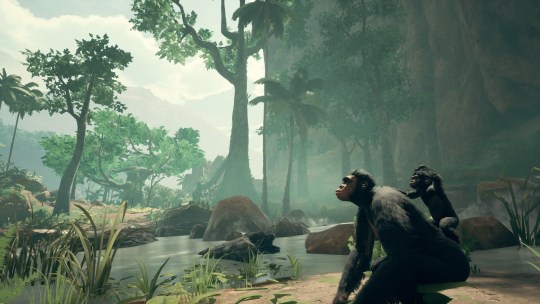
The game doesn’t have a story in the typical sense, but it takes place about 10 million years ago prior to current time in prehistoric Africa. The objective is to survive, learn, adapt, explore, and evolve from an ancient hominid known only as “The Missing Links”, evolving up to 2 million years prior to current time.
The game itself opens with a fish being caught by a pelagornis (an ancient pseudotooth bird), but drops it into the water, where it gets caught by a grey-crowned crane, but drops the now-dead fish when it gets attacked and eaten by a Thorbjarnarson's Crocodile. The fish is then picked up by an elderly male hominid with an infant on his back. Upon taking the fish to a high point to eat it, the hominid is taken away by a Bateleur Eagle to its nest, where it is killed and eaten as the infant falls to the ground below. Upon finding a hiding spot, perseptive switches to an adult, trying to find the lost infant. After that, the game opens up.

As stated before, this is a survival game with a wide open area to explore. The biggest thing about this game is that there are no maps, meaning the player must rely on recognizable locations to navigate. Though this isn’t entirely up to the player to remember, as the hominid can “remember” specific locations (only one at a time until later). The game encourages exploration and there are many ways to get around, most notable by swinging from branches to branches and climbing up cliffs and tree trunks. This is the best way to avoid many predators and enemies that can often be found on the ground floor.
There are many animals that can and will attack any and all available hominids. From predators such as the Machairodus (early Sabertooth Tigers), Crocodiles, Black-backed Jackals, and even Hyenas. Crawling Threats include Megarian Banded Centipede, African Rock Pythons, and Black and Green Mambas. While Irascible Threats (creatures that are typically passive, but can and will attack if the player gets too close) such as Giant Warthogs, African Buffalos, Hippos, Miocene Elephants (easily the strongest and most difficult animal), and even Miocene African Otters (which are far more aggressive and bigger than current otters).
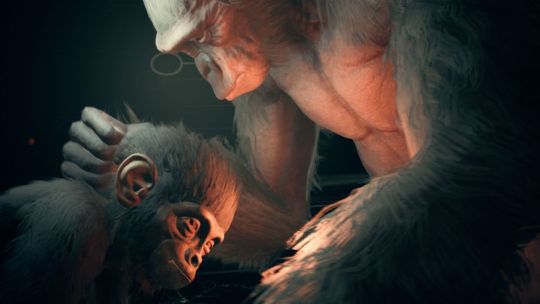
With a Clan, the player can control a single hominid and by bonding with another adult hominid of the opposite gender, a bond can be formed, making the two a couple, thus leading to procreation. Once a child is born, Neuronal Energy can be gained by performing certain actions and this Energy is used to Evolve the present Hominid. But if that Hominid dies, all Neurons (upgrades) are lost unless they had a child and said Neurons become permanently locked upon changing a generation.
And now, the time has finally come for my Final Recommendation:
Never Let Go Of It||Get It||Hold Onto It||Try It||Consider It||Stay Away From It
I won’t lie, this game isn’t for everyone. It can feel really slow at times and though this is a game that doesn’t hold your hand, it’s also the kind of game that tosses you into the deep-end of the pool while being tied to a 40-pound weight and expecting you to swim.before you drown. While you are told how to play the game and the general controls, they expect you to instantly remember everything. But at the same time, it can feel satisfying when things finally click and you can do things without really thinking about it. There are (in-game) days where you can do a lot of things and make tons of progress, while there are other days where things run slowly with little to no progress being made. I myself, despite enjoying the game, couldn’t play it two days in a row, as my interest wasn’t great enough to do so. I would take a break from the game for days or even weeks before picking it up again.
The A (XBox)/X (PS4) is used for almost everything. Picking up items, running, jumping, eating, sleeping, swinging, and dodging/attacking. The X (XBox)/Square (PS4) is used for hearing. B (XBox)/Circle (PS4) is used for smell. And Y (XBox)/Triangle) are used for “Intelligence”, which is what allows you to remember specific things, such as notable locations, animals, food, and items.
I couldn’t figure out where else to put this, but you’re given these side quests to do. They aren’t important in any way, but are there to encourage exploration and help you become more familiar with the idea. Pretty much all of them are about discovering a specific location. On to of encouraging exploration, the game also encourages experimentation and traveling outside your comfort zone. When you start the game, your clan’s territory is very small, but it doesn’t take long before you have to explore and enter unknown locations. When entering a new location, the hominid will become scared and you’re required to gain dopamine by identifying things nearby, such as fruit, items, and even other animals before finally conquering your fears.
And at various points in the game, you’ll be required (but not explicitly forced) to take your clan and move to another location. This, of course, can make your an easy target for enemies. But they can be scared away by using Intimidate, with your group scaring them away. Intimidate hardly ever works while on your own with only a few exceptions. You also have to be careful, as while many injuries won’t outright kill you, that can hamper your movements, making it harder to get away from enemies. Bleeding is especially dangerous, as it can slowly cause your primate to bleed to death unless treated. Not to mention falling from too great a height can cause you to get a broken leg, which can either heal naturally (after a considerable amount of time), or using certain food. But even greater will outright kill your hominid. And not just falling onto the ground, but even onto a tree branch you planned on swinging from will impale your hominid.
When at least one child is born, you can change the generation, causing time to leap forward a few years, causing infants to grow into adults, adults into elderly, and the elderly die. And any female adults become infertile upon becoming elders. This can only be done at your Clan Settlement, while accessing the Evolution Menu (which is also used to gain Neuron). You can do this to Lock in a Neuron, thereby making it permanent for all hominids from that point forward But you only get a certain number of locks relative to the amount of children born in that generation. So if there are any that aren’t locked, they must be regained again.
After passing a Generation, you can perform an Evolution Leap, allowing you to jump ahead several thousand years, gaining more with each Feat you perform, marked by a checklist based on what you’ve seen or done. The more you do, the more you jump ahead. And if you do or discover certain things before what science dictates (like standing upright before 4 million years ago), you get an “Ahead of Science” bonus, jumping ahead even more years. Births also count to how many years are added while deaths (not counting natural deaths) take away from it.
I also want to mention that when you finally reach 2 million years ago, you get a final cutscene and the game just ends right there. I won’t lie, it’s rather underwhelming. But apparently, this is only the first part in a trilogy.
So with that said, I’ll see you guys next month, where I take a look at a game that it impossible to buy now and you can’t play it unless you already owned it or use an emulator. And no, I’m not talking about PT.
9 notes
·
View notes
Note
according to the Battle of the Birds purple rift storybook, the Conductor does in fact have eyes. (I also imagine he's a small yellow pseudotoothed bird. Pseudotoothed birds were extant until about two million years ago. ) "trivia: the conductor does in fact have eyes" this game is so weird i love it
Of course he has eyes, you just can’t see them. With them being so covered up though he should have trouble seeing but clearly doesn’t. xD (Also, just checked, even in the storybook, his actual eyes aren’t visible, just the star cartoon effect on them.)
I was thinking his species might come from velociraptors; they had feathers and the mouth shape is pretty close. I’m not 100% sure about that headcanon though, in fics, I might just never mention it and let it be a mystery because no one but the Conductor knows.
Really, though since the game never addresses it, any headcanon is perfectly applicable. Someone wants to see him as a weird owl, extinct bird, dinosaur or anything else, all perfectly fine interpretations. xD
6 notes
·
View notes
Note
trick or treat :0
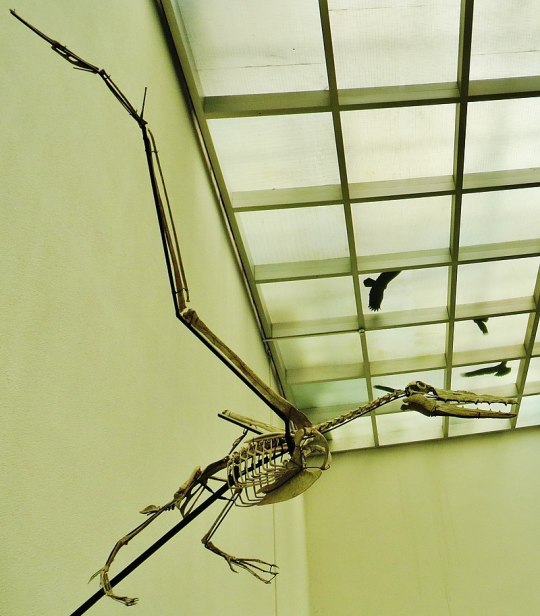
Dasornis!
21 notes
·
View notes
Text
Scientists discover one of world's oldest bird species at Waipara, New Zealand
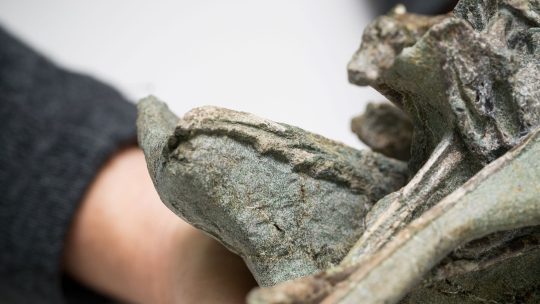
The ancestor of some of the largest flying birds ever has been found in Waipara, North Canterbury.
Bony-toothed birds (Pelagornithids), an ancient family of huge seafaring birds, were thought to have evolved in the Northern Hemisphere—but that theory has been upended by the discovery of the family's oldest, but smallest member in New Zealand.
At 62 million-years-old, the newly-discovered Protodontopteryx ruthae, is one of the oldest named bird species in the world. It lived in New Zealand soon after the dinosaurs died out.
While its descendants were some of the biggest flying birds ever, with wingspans of more than 5 meters, Protodontopteryx ruthae was only the size of an average gull. Like other members of its family, the seabird had bony, tooth-like projections on the edge of its beak.
The seabird fossil was identified by the same team that recently announced the discovery of a 1.6 meter-high giant penguin from the same site.
Amateur paleontologist Leigh Love found the partial Protodontopteryx skeleton last year at the Waipara Greensand fossil site. The bird was named Protodontopteryx ruthae after Love's wife Ruth. Love wanted to thank her for tolerating his decades-long passion for paleontology.
Fellow amateur Alan Mannering prepared the bones, and a team comprising Love, Mannering, Canterbury Museum Curators Dr. Paul Scofield and Dr. Vanesa De Pietri and Dr. Gerald Mayr of Senckenberg Research Institute and Natural History Museum in Frankfurt, Germany, described Protodontopteryx.
Dr. Scofield says the age of the fossilized bones suggests pelagornithids evolved in the Southern Hemisphere. "While this bird was relatively small, the impact of its discovery is hugely significant in our understanding of this family. Until we found this skeleton, all the really old pelagornithids had been found in the Northern Hemisphere, so everyone thought they'd evolved up there."
"New Zealand was a very different place when Protodontoperyx were in the skies. It had a tropical climate—the sea temperature was about 25 degrees so we had corals and giant turtles," he adds.
Dr. Mayr says the discovery of Protodontopteryx was "truly amazing and unexpected. Not only is the fossil one of the most complete specimens of a pseudotoothed bird, but it also shows a number of unexpected skeletal features that contribute to a better understanding of the evolution of these enigmatic birds."
Later pelagornithid species evolved to soar over oceans with some species measuring up to 6.4 meters across the wings.
Protodontopteryxs' skeleton suggests it was less suited for long-distance soaring than later pelagornithids and probably covered much shorter ranges. Its short, broad pseudoteeth were likely designed for catching fish. Later species had needle-like pseudoteeth which were likely used to catch soft-bodied prey like squid.
Dr. De Pietri says "because Protodontopteryx was less adapted to sustained soaring than other known pelagornithids, we can now say that pseudoteeth evolved before these birds became highly specialized gliders."
The last pelagornithid species died out around 2.5 million years ago, just before modern humans evolved.
The Waipara Greensand site where the Protodontopteryx skeleton was found has yielded several important scientific discoveries in recent years, including ancient penguins and the world's oldest tropicbird fossil.
Some of these discoveries, including the Protodontopteryx fossil, will be displayed in an exhibition about ancient New Zealand at the Museum later this year.
This research was funded by the Royal Society of New Zealand's Marsden Fund and is published today in the journal Papers in Palaeontology.
Provided by: Canterbury Museum
More information: Gerald Mayr et al. Oldest, Smallest And Phylogenetically Most Basal Pelagornithid, From The Early Paleocene Of New Zealand, Sheds Light On The Evolutionary History Of The Largest Flying Birds. Papers in Palaeontology (2019). DOI: 10.1002/spp2.1284
Image: 'Protodontopteryx' fossil showing the bony, tooth-like projections on the bird’s beak.
Credit: Canterbury Museum. Image Available CC BY NC and for News and Current Affairs Use
Read the full article
0 notes
Photo

Weird Heads Month #29: Giant Saw-Toothed Birds
The pelagornithids, or "pseudotooth birds", were a group of large seabirds that were found around the world for almost the entire Cenozoic, existing for at least 60 million years and only going completely extinct just 2.5 million years ago.
Their evolutionary relationships are uncertain and in the past they've been considered as relatives of pelicaniformes, albatrosses and petrels, or storks, but more recently they've been proposed to have been closer related to ducks and geese instead.
Whatever they were, they were some of the largest birds to ever fly, and many of the "smaller" species still had wingspans comparable to the largest modern flying birds.
But their most notable feature was their beaks. Although at first glance they look like they were lined with pointy teeth, these structures were actually outgrowths of their jaw bones covered with keratinous beak tissue. While these bony spikes would have been useful for holding onto slippery aquatic animals like fish and squid, they were actually hollow and relatively fragile so pelagornithids must have mainly caught smaller prey that couldn't thrash around hard enough to break anything.
The serrations also only developed towards full maturity, and the "toothless" juveniles may have had a completely different ecology to adults.
Pelagornis chilensis here was one of the larger species of pelagornithid, with a wingspan of 5-6m (16'4"-19'8"), known from the western and northern coasts of South America during the late Miocene about 11-5 million years ago.
Like other pelagornithids it was highly adapted for albatross-like dynamic soaring, with long narrow wings that allowed it to travel huge distances while expending very little energy – but with its proportionally short legs it would have been clumsy on the ground and probably spent the vast majority of its life on the wing, only returning to land to breed.

———
Nix Illustration | Tumblr | Pillowfort | Twitter | Patreon
#weird heads 2020#science illustration#paleontology#paleoart#palaeoblr#pelagornis#pelagornithidae#pseudotooth bird#odontopterygiformes#galloanserae#bird#dinosaur#art#an odd duck#maybe#it's a lovely morning in the miocene and you are a horrible pelagornithid#deliberately visually emphasizing the duckishness because i haven't seen anyone actually do that with these guys
142 notes
·
View notes
Text
Fossil Novembirb: Day 7 - Ancient London Town
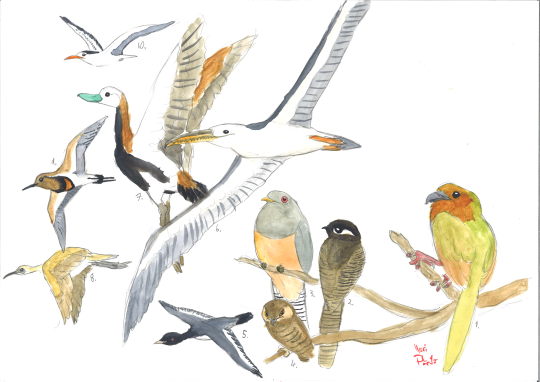
The 50 million year old fossil site of London Clay preserves impressive fossils of early Eocene birds. Back then, during the PETM, the city of London was near a tropical shoreline, and the land was covered with forests of tropical trees and palm groves. In this hot house world, birds were diversifying rapidly, and lots of strange forms lived in London Clay.
Pulchrapollia: This pretty bird belongs to a lineage related to parrots and had parrot-like feet, but was not a close relative of them. This bird had a corvid-like beak and was likely an omnivore, like jays today.
Archaeodromus: A relative of swifts, potoos and nightjars that hawked after insects, catching them in its huge mouth.
Eotrogon: An early relative of the modern trogons and quetzals. It dove after insects and fruit from its high perch.
Ypresiglaux: Among the earliest known owls, and also one of the smallest. Despite its small stature, it was a fearsome predator of insects and small vertebrates.
Nasidytes: The earliest known loon (or diver). Like its modern relatives, it was an aquatic predator of fish and invertebrates, diving beneath the surface to catch its prey.
Dasornis toliapica: A species of pelagornithid, which were large pseudotoothed soaring seabirds. This small species had a wingspan of "only" three metres.
Nettapterornis: A wading waterfowl related to modern ducks that used its long legs and flat bill to filter food from the water.
Lithornis vulturinus: An ancestral palaeognath that was perfectly capable of long distance flight. It had a flexible beak to help catch its prey.
Charadriisimilis: A small wader that was related to the same group as oystercatchers, sandpipers and plovers. It used its long legs and beak to catch small animals from the sediment.
Prophaethon: An early relative of modern tropicbirds. It could swim and fly well, and may have had a niche similar to modern gulls or terns.
#Fossil Novembirb#Novembirb#Dinovember#palaeoblr#birblr#Birds#Dinosaurs#Cenozoic Birds#Pulchrapollia#Archaeodromus#Eotrogon#Ypresiglaux#Nasidytes#Dasornis#Nettapterornis#Lithornis#Charadriisimilis#Prophaethon
46 notes
·
View notes
Text
ITS ALMOST FOSSIL NOVEMBIRB!!!!!
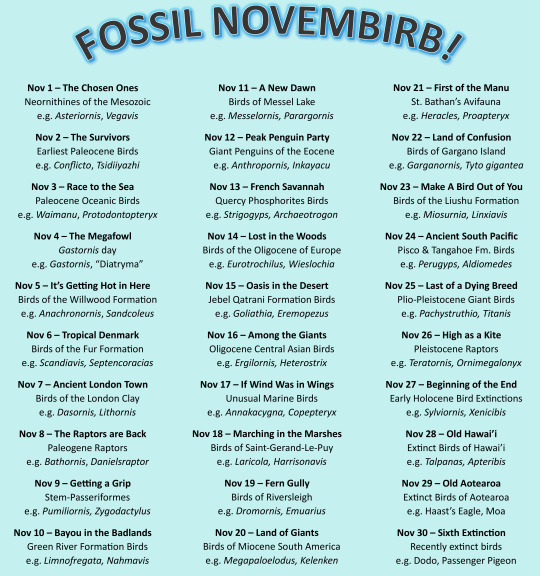
We're going to have a CELEBRATION of FOSSIL NEORNITHINES for this November!!! The extinct members of the only group of dinosaurs we have today!
Each day will have a prompt inspired by the evolution of crown-birds and the amazing forms they have taken over the past 68 million years!
You can respond to each day's prompt however you wish - with drawing and painting, writing, sculpting, music, videos, whatever! Just tag it "#Fossil Novembirb" for me to find it, and it'll get reblogged!
I'm so excited to see the art you guys create!
NOVEMBER 1 - THE CHOSEN ONES
Crown-Birds (Neornithes) known from the Mesozoic Era!
Options include Asteriornis, Teviornis, Vegavis, and "Styginetta"!
These are the only dinosaurs that survived the asteroid!
Theoretically there were also early Palaeognaths and Neoavians - if you want to do some spec evo and hypothesize what you think they might have looked like, go ahead! Follow your dreams!
NOVEMBER 2 - THE SURVIVORS
The earliest birds known after the K-Pg boundary!
Options include Conflicto, Tsidiiyazhi, Australornis, Qinornis, and Qianshanornis!
Birds diverged rapidly after the extinction, so also feel free to dive into spec evo into some of the forms we don't have fossils of!
NOVEMBER 3 - RACE TO THE SEA
The first Marine Neornithines and how they evolved in the early Paleocene!
Includes tons of early penguins like Waimanu, Kumimanu, Sequiwaimanu, Muriwaimanu, and Kupoupou
Also includes the first Pseudo-toothed bird, Protodontopteryx, and the earliest known Tropicbird, Clymenoptilon!
RISE OF THE PENGUINS!
NOVEMBER 4 - THE MEGAFOWL
Gastornis (aka "Diatryma", aka "Zhongyuanus") appeared in the mid-Paleocene and was a feature of the Cenozoic landscape until the end of the Eocene - so we have a whole day JUST FOR IT
Show your love for the Megafowl Gastornis! This giant herbivorous bird was fascinating, and has captured imaginations for decades because of it!
Gastornis is also present in many of the ecosystems described below, such as Willwood, Green River, and Messel, so we also just wanted to make sure people didn't keep picking Gastornis over and over again xD
NOVEMBER 5 - IT'S GETTING HOT IN HERE
The Paleocene-Eocene Thermal Maximum was the most dramatic incident of rapid global warming in the world since the Permian... until today!
It majorly affected the evolution of many things, possibly including birds!
The Willwood Formation straddles the time period of the warming, and has tons of birds that were evolving during that time period! So, for this day, create things involving birds of the Willwood Formation!
Options include the flighted Palaeognaths Lithornis promiscuus and Lithornis plebius; the possible stem-Ostrich Paragrus, the early half-screamer-half-duck Anachronornis, the early owl Primoptynx, and the fascinating stem-mousebird Sandcoleus! And many more!
NOVEMBER 6 - TROPICAL DENMARK
Birds of the Fur Formation, one of the best collections of bird fossils from the early Eocene!
Includes such friends as Scandiavis (an early shorebird), Septencoracias (an early roller), Pellornis (an early rail-esque thing), the utterly mysterious Morsoravis, and the early swift-hummingbird Eocypselus!
This was a tropical shoreline environment with many of the first members of major bird groups we see today!
NOVEMBER 7 - ANCIENT LONDON TOWN
Across the shore from Fur was the London Clay Formation, a lush tropical forest near the warm shallow ocean
In addition to a truly alarming quantity of plant fossils, this is a notable locality for early birds, featuring many early members of major groups much like the Fur Formation
Options include Dasornis (a pseudotoothed bird), Pulchrapollia (one of the Parrot-Passerines of Prey), Nettapterornis (another stem-duck), Nasidytes (an early loon), Charadriisimilis (an early shorebird), Archaeodromus (a trogon-like member of Strisores), Eotrogon (an actual early Trogon), Lithornis vulturinus (another flighted Palaeognath), Prophaethon (another early Tropicbird), and Ypresiglaux (an early owl) - and so many more!
NOVEMBER 8 - THE RAPTORS ARE BACK
Turns out "Predatory Feathered Thing with Really Sharp Foot Claws" is a very successful niche - not only was there potentially one right after the end of the Cretaceous (Qianshanornis), but other raptors were some of the first birds to succeed around the world in the Eocene
So this day is dedicated to the early raptors of the Cenozoic!
Any "raptor" from the Paleogene is valid - so here are some suggestions:
Early Cariamiformes (Seriemas and Kin) like Bathornis, Dynamopterus, Strigogyps, and the first potential Terror Birds like Paleopsilopterus
Early Owls like Ypresiglaux and Palaeoglaux
Early Accipitriformes like Horusornis
Early Falcons like Antarctoboenus, Masillaraptor, and Danielsraptor
And of course the ever popular "Parrot-Passerines of Prey" like Tynskya and Messelastur
NOVEMBER 9 - GETTING A GRIP
Half of all living birds are Passeriformes - aka "Perching Birds" - but this wasn't always the case! For most of Earth's history, many other kinds of tree birds were extremely common
Where did this behemoth group of tiny dinosaurs come from? That's the subject of this day's prompt!
In the Eocene, the first birds closer to Passeriformes than to Parrots evolved, and they came in a huge variety of forms! So on Nov 9th, we're going to celebrate this group's interesting beginnings!
Options for this include Parapsittacopes, Eofringillirostrum, Pumiliornis, Psittacopes, Zygodactylus, Primozygodactylus, Psittacomimus, Sororavis, Morsoravis, and Eozygodactylus! Go wild!
NOVEMBER 10 - BAYOU IN THE BADLANDS
Back to specific ecosystems! We're visiting the world-famous Fossil Lake of the Green River Formation!
This environment, during the Early Eocene, was a thriving tropical lake and forest ecosystem filled with tons of early Neornithines as well as mammals and other animals
Gorgeous fossils have come out of this lake, showing truly amazing detail of feathers and other features for these birds!
So here you can feature Prefica (a potential early Oilbird), the flighted Palaeognath Calciavis, the stem-turaco Foro, the early mousebird Celericolius, the possible shore-bird Nahmavis, a potential cuckoo roller Plesiocathartes, the Flamingo-Duck Presbyornis, the early landfowl Gallinuloides, the swift-hummingbird Eocypselus, and the Frigate Bird Trying at being a Gull Limnofregata - and so many more!
NOVEMBER 11 - A NEW DAWN
We're finally moving on to the middle Eocene - and the Messel Lake ecosystem, famous from the first episode of Walking with Beasts (hence the name of the day)!
(If you're going "wait, that episode acts like nothing happened between the K-Pg and Messel, but here you have 10 days worth of stuff" .... yeah. Walking With Beasts skipped the Paleocene and early Eocene and I am... very pissed. Still.)
You know about the tons of early mammals from this tropical lake ecosystem, but it was filled with tons of early birds as well!
There's the early ostrich Palaeotis, the crane-rail Messelornis, the almost-flamingo Juncitarsus, the freshwater Booby Masillastega, the early hoopoe Messelirrisor, Selmes (a mouse bird with stubby toes), the early ibis Rhynchaeites, the early nightbird Hassiavis, the early swift Scaniacypselus, an early roller with known colors Eocoracias, and the early potoo Paraprefica - and many others!
NOVEMBER 12 - PEAK PENGUIN PARTY
As the Eocene continued, penguins achieved true megafaunal status - there were tons of them, they were huge, and they were all over the oceans of the Southern Hemisphere
While penguin diversity never did recover after the Eocene-Oligocene extinction event, this golden age deserves celebration!
Some of these fascinating peak penguins include Palaeeudyptes, Anthropornis, Icadyptes, Inkayacu, Perudyptes, and Kairuku!
NOVEMBER 13 - FRENCH SAVANNAH
As the Eocene began to dry up and cool down, plains grew across the world where the tropical forests once had been
One of the most famous later-Eocene fossil sites for birds is the Quercy Phosphorites location, a French formation with tons of interesting fossil birds!
Here we start to see the early forms of Neornithine Dinosaurs we saw in the Paleocene-Early Eocene diverge and specialize further - often in particularly weird or interesting ways!
So here we have the duck-ish chicken Paraortyx, the secretarybird Pelargopappus, you can also bring back Dynamopterus from earlier, there is the stem-chicken Quercymegapodius as well as stem-parrots like Quercypsitta, the seriema-like Strigogyps, the sandgrouse relative Archaeoganga, Archaeotrogon shows up again, the swift relative Aegialornis, a potential woodpecker relative Sylphornis, and more owls like Palaeoglaux! Lots of cursorial predators in this ecosystem!
NOVEMBER 14 - LOST IN THE WOODS
As the Oligocene dawned, forests did grow back in Europe, though they were now temperate and dry as opposed to the paratropical rainforests of before
This lead to wide diversification of tree-dwelling birds, and so here we will celebrate the birds of the Oligocene of Europe!
We start to really see modern-esque birds at this point, though of course we still have 30 million years of evolution to go!
Here you can feature the early eagle/hawk Aviraptor, the European Hummingbird Eurotrochilus, the seabird relative Rupelornis, the early woodpecker-toucan Rupelramphastoides, the tody Palaeotodus, the proper Passerine Wieslochia, the possible shorebird Turnipax, the mousebird Oligocolius, the hoopoe Laurillardia, and the trogon Primotrogon which we know the colors of!
NOVEMBER 15 - OASIS IN THE DESERT
The Jebel Qatrani Formation of Egypt shows the beginnings of the famous African Grassland animals, as well as many early members of iconic African animal groups such as primates - and, of course, birds!
Taking place in the early Oligocene, this formation was a tropical/subtropical lowland plain filled with ponds and streams and other waterways - aka, tons of swamps surrounded by plains
As such, this place is infested with waterbirds!
Here we have a fossil relative of the Shoebill Goliathia, as well as the jacanas Janipes and Nupharanassa, the giant stork Palaeoephippiorhynchus, the herons Nycticorax and Xenerodiops, and the mystery Palaeognath Eremopezus!
NOVEMBER 16 - AMONG THE GIANTS
Once again we're just fully committing to the Walking With Beasts nostalgia bc these are the birds we wish were in it more okay we said it
Anyways there were some interesting large birds in the plains of the "Land of Giants" episode so picture these guys alongside the Indricothere etc.
In general we're covering the latest Eocene through the Oligocene of Central Asia
Here we have the enigmatic ratites Ergilornis and Sonogrus, the pseudo-toothed bird Caspiodontornis, the owl Heterostrix, and the stem-flamingo Agnopterus
NOVEMBER 17 - IF THE WIND WAS IN OUR WINGS
We all focus on penguins, but over the Cenozoic, plenty of weird birds have evolved for marine life, and boy are they bizarre!
So for Nov 17, we're focusing on the unusual marine birds of the Cenozoic!
This includes any members of the Pelagornithids - aka the Pseudo-toothed birds - as well as the Plotopterids - the Boobies that became Penguins! Pelagornis and Copepteryx are the best known taxa from each, respectively, but there are plenty more!
But that's not all! We have the flightless auks Miomancalla and Mancalla, the large flightless marine duck Chendytes, and who can forget the weird flightless marine swan Annakacygna! Tons of options to choose from!
NOVEMBER 18 - MARCHING IN THE MARSHES
We're now starting our transition from the Paleogene into the Neogene, beginning with the brackish marsh ecosystem preserved at Saint-Gerand-Le-Puy in France!
This Miocene locality preserves a wide variety of birds that are near modern, but not quite - a sort of "uncanny valley" of bird evolution, all set in a somewhat-salty somewhat-not wetland ecosystem
Options for dinosaurs here include Harrisonavis, a transitional flamingo; the early gull/tern Laricola, the enigmatic duck Mionetta, the stork Grallavis, the pratincole Becassius, the swimming-flamingo Palaelodus, the early cormorant Nectornis, the seed-eating pheasant Palaeortyx, the early loon Colymboides, and the mysterious shorebird Elorius!
NOVEMBER 19 - FERN GULLY
Riversleigh is one of the most famous fossil sites in the world, preserving the evolution of the strange and unique animals known today in Australia, during the Oligocene to Miocene transition
Most often, we focus on the bizarre mammals found at Riversleigh, and for good reason - it's a Marsupial Party! - but the birds here are fantastic as well
This ecosystem was a rich rainforest that transitioned over the period of deposition into a semiarid grassland, and covers 20 million years of animal evolution during that transition
Options for birds here include the butcherbird Kurrartapu, the fossil Sittella Daphoenositta trevorworthyi, the Mihirungs ("Demon Ducks") Dromornis and Barawertornis, the Emuwary Emuarius, the early magpie-goose Eoanseranas, the raptor Pengana with flexible ankles, the earliest known species of lyrebird (Menura tyawanoides), the corvid-like Corvitalusoides, the first known cockatoos, the flightless rail-like bird Australlus, the stiff-tailed duck Pinpanetta, the early logrunner Orthonyx kaldowinyeri, and so many more!
NOVEMBER 20 - LAND OF GIANTS
Y'all were probably wondering when we'd get to the Terror Birds and other interesting dinosaurs of South America, so - here we are!
South America, isolated from the rest of the world until the Great American Interchange, featured a wide variety of bizarre and unique animals - not just mammals, but birds and other reptiles as well!
So for Nov 20th, we're looking at the interesting dinosaurs of the "lost continent" during the Miocene epoch, prior to the invasion of North American taxa!
Any Miocene South American Terror Bird (Phorusrachid) is fair game here, so that includes Brontornis, Patagorhacos, Paraphysornis, Devincenzia, Kelenken, Phorusrhacos, Patagornis, Andalgalornis, Psilopterus, Mesembriornis, and Procariama! Note that they did not all live at the same time or even close to each other in location, so do your research on the taxa you pick!
But Terror Birds weren't the only strange dinosaurs in South America at the time! We have the large Teratorn (vulture-like-thing) Argentavis, the *giant* swimming-flamingo Megapaloelodus, the giant Anhinga Macranhinga, the rhea Opisthodactylus, the penguins Palaeospheniscus, Arthrodytes, and Paraptenodytes, the Cathartid Dryornis, the Jacamar Galbula hylochoreutes, fossil Hoatzins like Hoazinavis and Hoazinoides, the giant stork Leptoptilos patagonicus, and the owl Yarquen!
NOVEMBER 21 - FIRST OF THE MANU
Aotearoa has one of the most unique avifaunas in the world today, and I often call it "Mesozoic 2" because of its almost entirely dinosaur-dominated fauna, especially in the past
All great things have to start somewhere or when, and for Aotearoa, that somewhen was after the landmass resurfaced from the ocean for the first time in millions of years - and was quickly inhabited by all kinds of birds and other reptiles (including tuatara) in the Miocene
This ecosystem was a lake bordered by grassy wetland floodplains and subtropical forests, a bit warmer than Aotearoa today
Dinosaurs here include the early Kiwi Proapteryx, an unnamed early Moa, a truly alarming number of waterfowl including shelducks like Miotadorna, stiff-tailed ducks like Manuherikia, and the possible swan Notochen, the small swimming-flamingo Palaelodus aotearoa, pigeons like Rupephaps and Deliaphaps, an early adzebill Aptornis proasciarostratus, flightless rails like Priscaweka, the lake-wanderer Hakawai melvillei, the herons Pikaihao and Matuku, the giant parrot Heracles, proto-keas Nelepsittacus, and the New Zealand Wren Kuiornis. Tons of fun species to choose from!
NOVEMBER 22 - LAND OF CONFUSION
In the Late Miocene to Early Pliocene, the Italian province of Gargano was cut off from the mainland due to rising sea levels, turning it into an island - an island with lots of really strange birds!
This island was cut off from everything else and completely lacked large predators, allowing for a weird variety of animals to evolve and thrive prior to the island rejoining the mainland during the Ice Age
Strange birds of this ecosystem include the extremely old pigeon Columba omnisanctorum, the giant hawk Garganoaetus, the giant flightless goose Garganornis, the giant barn owl Tyto gigantea, the pheasant Palaeortyx volans, and the swift Apus wetmorei!
NOVEMBER 23 - MAKE A BIRD OUT OF YOU
The iconic animals of the Ice Age and recent prehistory had to come from somewhere, and much of this transition is recorded in the Chinese Ecosystem of the Liushu Formation, deposited between 11 and 6.4 million years ago
As grasslands expanded, this ecosystem transitioned from a forest to a wide plains, and many animals adapted for the grasslands accordingly, leading to the appearance of such mammals as Elasmotheriines, Sabercats, Hyenas, Ambelodonts, and a truly alarming quantity of hoofed mammals
Dinosaurs (Birds) adapted to this ecosystem change as well, of course! While most focus on the mammals of Liushu, we're here to showcase the interesting birds that appeared here as well!
Options here include the the very well preserved Falcon Falco hezhengensis, the vultures Mioneophron and Gansugyps, the diurnal owl Miosurnia, the vocally fancy pheasant Panraogallus, the sandgrouse Linxiavis, the Ostrich Struthio (or Orientornis) linxiaensis, and the probable-Ostrich Sinoergilornis
NOVEMBER 24 - ANCIENT SOUTH PACIFIC
Penguins are Bouncing Back! As the Miocene continued and the Pliocene began, many new types of marine birds showed up and were fossilized in locations in Chile (Pisco) and Aotearoa (Tangahoe)
Tons of interesting birds were preserved in this sort of transitional ecosystem, showcasing how birds adapted to changing conditions as the Miocene-Pliocene climatic turmoil continued
These near shore environments are probably more famous for their other animals - things like the giant shark "megalodon", as well as weird whales like Livyatan and Odobenocetops and aquatic giant sloths (like Thalassocnus) and marine crocodilians - but we're here for those dinosaurs!
Options here from the Pisco Formation include the "Toucan-Booby" Ramphastosula, the Cathartid Perugyps, the Booby Sula figueroae, Pelagornithids, Pelicans, and the penguins Spheniscus urbinai and Spheniscus megaramphus, whereas birds from the Tangahoe Formation include the narrow-beaked albatross Aldiomedes, the giant petrel Macronectes, the more regular-sized petrel Procellaria altirostris, the little penguin Eudyptula wilsonae, and the crested penguin Eudyptes atatu!
NOVEMBER 25 - LAST OF A DYING BREED
We all love Megafuana, even though they are usually the "Live Fast Die Young" kind of species - gobbling up resources and growing too big will do that to you
Usually when we hear the term "Megafauna" we think of Mammals and Non-Avian Dinosaurs, but birds have had their share too - and have lost their share as well
So, mainly to cater to the Megafauna Fanbase, here we dedicate a whole day to the giant birds of recent times - Pliocene through Pleistocene - that we have lost to the dramatic climate change of the Ice Age Era. (Those lost in the Holocene will get their own days, see below)
Options for this day include the giant ostrich Pachystruthio, the Mihirung Genyornis, the Terror Bird Titanis, the giant stork Leptoptilos robustus, the giant swan Cygnus falconeri, the giant Anhinga Giganhinga, and of course - we can't forget our friend - the last of the Pseudotoothed Birds, Pelagornis
NOVEMBER 26 - HIGH AS A KITE
In many ways, the real dinosaur winners of the Ice Age were the flying Birds of Prey, as there were many kinds of raptors during the Ice Age and they exploited the new environment expertly
Nothing like being able to traverse huge distances to find places where there are food, amiright?
So this day is dedicated to the fantastic Raptors of the Ice Age, both volant and not!
Here we have some of the last of the Teratorns like Teratornis itself, the Giant Australian Raptor Dynatoaetus, the Australian Vulture Cryptogyps, Woodward's Eagle Buteogallus woodwardi, the tiny Condor Wingegyps, the large Cuban Eagle Gigantohierax, the wandering vulture Neogyps, the Walking Eagle Buteogallus daggetti, the Giant Cuban Stilt-Owl Ornimegalonyx, and one of the last Terror Birds, Psilopterus
NOVEMBER 27 - BEGINNING OF THE END
Oh Holocene Extinctions. As upsetting as they are, they include some of the best known fossil/subfossil birds, so we decided to spend a little extra time on them than they should have based solely on the time length
Here, we highlight the early losses of the Holocene - those dinosaurs that went extinct at the start, largely due to direct human activity such as hunting in addition to the warming caused by the end of the last Ice Age/Glacial Maximum
Days will be dedicated to both Hawai'i (see below) and Aotearoa (again, below), so this is for everyone else!
So options here include the previously mentioned marine duck Chendytes, the giant flightless landfowl Sylviornis from New Caledonia, the famous Elephant Birds of Madagascar, the flightless clubbing-ibis Xenicibis, the weird puffin Fratercula dowi, the giant Bahama Eagle Titanohierax, the Californian Turkey Meleagris californica, and the flightless "Cave Rail" Nesotrochis of the Greater Antilles
NOVEMBER 28 - OLD HAWAI'I
Many, many, MANY unique dinosaurs live on islands. The islands of Hawai'i are no exception, and these islands have lost many unique and fascinating birds over the years - thanks to human activity, invasive cats, colonialism, and climate change
We couldn't possibly ignore them, so for this day, we are hilghlighting these amazing animals found across the archipelago
There are tons of options, but some of our recommendations include the reverse-platypus/Mole Duck Talpanas, the Stilt-Owl Grallistrix, the flightless ibis Apteribis, the Moa-Nalo like Chelychelynechen, Ptaiochen, and Thambetochen, the Wood Harrier Circus dossenus, Hawai'ian Honeycreepers like Drepanis, Aidemedia, Hemignathus, Chloridops, Akialoa, Rhodacanthis, Dysmorodrepanis, Telespiza, and Vangulifer, the Oloma'o and ʻĀmaui thrushes, ʻōʻō's/Hawai'ian Honeyeaters like the Kioea, Kauaʻi ʻōʻō, and Oʻahu ʻōʻō, the giant Hawai'i Goose, the nēnē-nui/wood-walking goose, the Robust Crow, the flightless Laysan Rail, and the O'ahu Petrel
NOVEMBER 29 - OLD AOTEAROA
We're finally here: Pre-Human Holocene Aotearoa, aka Mesozoic 2, aka The Land Where Mammals Ain't Shit
I love Aotearoa so much. Why wasn't I born there. The universe isn't fair.
The ecosystems were very similar to today - podocarp forests and southern beech forests, grass and tussock plains and shrublands, and plenty of coastal habitats, all usually temperate in terms of climate
All named Moa are fair game. All of them, all named members of Dinornithiformes. So the North Island Giant Moa, the South Island Giant Moa, the Bush Moa, the Eastern Moa, the Broad-Billed Moa, the Heavy-Footed Moa, Mantell's Moa, the Crested Moa, and the Upload Moa. Follow your Moa-Filled Dreams!
Obviously there were more than Moa - not just the living species of Aotearoa still with us, but tons of other extinct forms for Fossil Novembirb. This includes the Adzebills, Haast's Eagle (of course), the whēkau/Laughing Owl Ninox albifacies, the New Zealand Goose Cnemiornis, the New Zealand Owlet-Nightjar, the mehonui Diaphorapteryx, the Long-Billed Wren Dendroscansor, the piopio Turnagra, and the Huia
NOVEMBER 30 - SIXTH EXTINCTION
And, for our last day, we cover recent Holocene extinctions (not on Hawai'i or Aotearoa) - the birds/dinosaurs we have lost in the living past, due largely to colonialism, capitalism, globalism, and climate change
Any bird extinct since 1492 not previously covered is fair game, and there are a lot of them. Today, we honor them, however we can.
Some suggestions include the Dodo (of course), the Cuban Macaw, the Pink-Headed Duck, the Northern Curlew, the Great Auk, the Passenger Pigeon, the Carolina Parakeet, the Ivory-Billed Woodpecker, the Labrador Duck, the Saint Helena Hoopoe, and the Spectacled Cormorant; though there are of course many otherse to choose from as well
Kind of a bummer note to end on, but here we are
Living Birds already get tons of time and attention, so we really don't want to include them here - we love them, but the fossils of the Neornithes world deserve love too! So we tried to cover all of the bases, as best as we could!
Remember, Wikipedia, the Paleobiology Database, The Works of Gerald Mayr, the third volume of "Earth Before Us", and the blogs of myself and @albertonykus and @otussketching are all fantastic resources to look for information about these wonderful animals! Also check out Through Time and Clades' "Dinosaurs: The Second Chapter" series and the Raptormaniacs blog from Albert as well!
HAVE FUN! CREATE WHAT YOU DREAM! AND LOVE CENOZOIC DINOSAURS!
HAPPY FOSSIL NOVEMBIRB!
#Fossil Novembirb#Novembirb#Dinovember#birblr#palaeoblr#Birds#Dinosaurs#Cenozoic Birds#Neornithines#Dinovembirb
611 notes
·
View notes